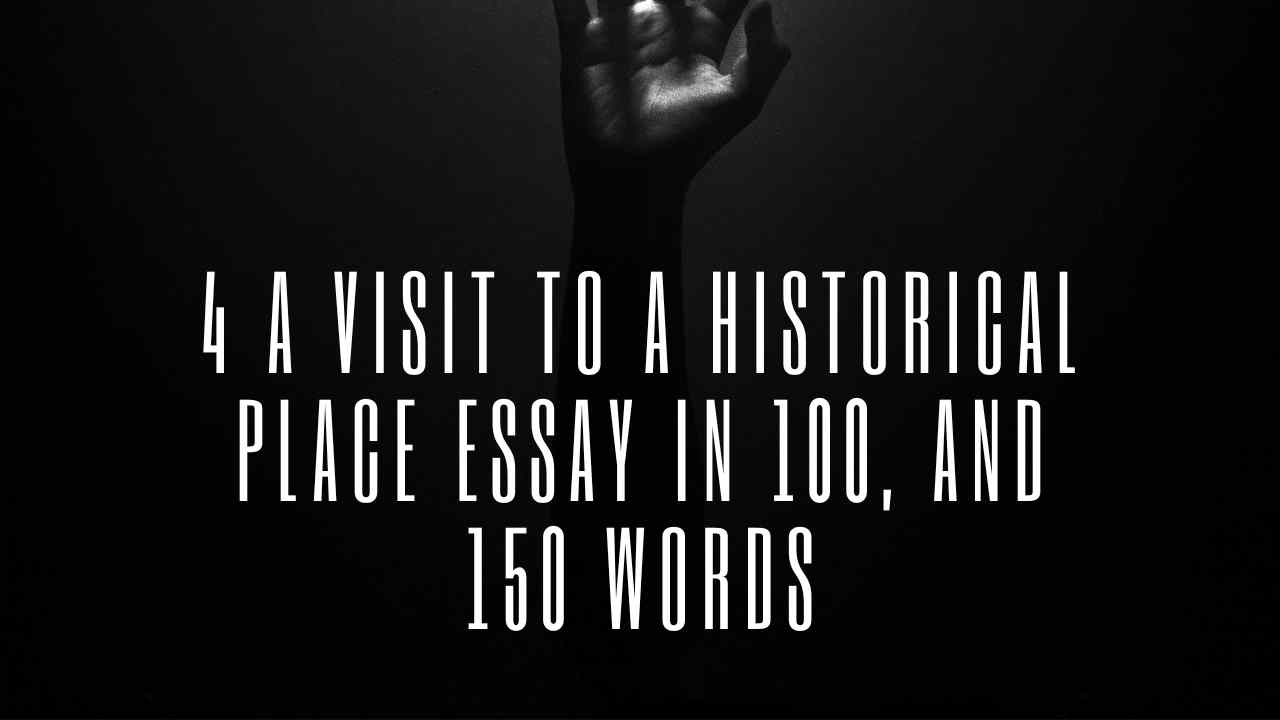4 A Visit to a Historical Place Essay in 100, and 150 Words
Here, we are presenting long and short 4 A Visit to a Historical Place Essay in English for students under word limits of 100 words, and 150 words. This topic is useful for students of classes 1, 2, 3, 4, 5, 6, 7, 8, 9, 10, 11, and 12 in English. These provided essays will help you to write effective essays, paragraphs, and speeches.
First A Visit to a Historical Place Essay in 100 Words
Essay Title: A Day at Red Fort: Exploring India’s Rich History
Introduction:
A visit to the Red Fort is like stepping back in time, as history echoes through its majestic walls. It stands proudly in the heart of Old Delhi, as a reminder of India’s glorious past.
Impressive Architecture:
Emperor Shah Jahan built the Red Fort in the 17th century, and it is a marvel of Mughal architecture. Its red sandstone walls, intricate carvings, and grand gates reflect the craftsmanship of the time.
Historical Significance:
Walking through the fort, you can feel the pulse of history. It was the main residence of Mughal emperors for centuries and witnessed major events such as India’s independence celebrations in 1947.
Diwan-i-Aam, Diwan-i-Khas:
The Diwan-i-Aam, where the emperor addressed the public, and the Diwan-i-Khas, which was reserved for private audiences, provide an insight into the opulence of Mughal court life.
Sound and Light Shows:
As the sun sets, a captivating sound and light show narrates the fort’s history, bringing the past to life through vivid colors and compelling stories.
Conclusion:
A visit to the Red Fort is more than just a tour; it is a journey through time, an opportunity to connect with India’s rich heritage and admire the architectural brilliance of the Mughal era.
A Visit to a Historical Place Essay in 100 Words
Essay Title: A Journey Through History: Exploring Hawa Mahal
Introduction:
A visit to the historical Hawa Mahal is like stepping into another era. This majestic structure in Jaipur, India, represents the region’s rich architectural and cultural heritage.
Architectural Marvels:
The Hawa Mahal, also known as the Palace of Winds, is an outstanding example of Rajput architecture. Its distinctive design, which included intricate latticework and numerous small windows, enabled royal women to observe street festivals without being seen. The pink sandstone facade adds a touch of grandeur to the structure, making it aesthetically pleasing.
Historical Significance:
Hawa Mahal, built in 1799 by Maharaja Sawai Pratap Singh, was used as a royal women’s summer retreat. It has historical significance because it serves as a symbol of Jaipur’s rich cultural and architectural heritage.
A Glimpse into Royal Life:
Walking through the corridors of the Hawa Mahal reveals the opulent lifestyle of Rajasthan’s royal families. The intricately decorated chambers and panoramic views from the top provide a unique glimpse into a bygone era.
Conclusion:
A visit to the Hawa Mahal is more than just a historical journey; it is a captivating experience that allows one to appreciate India’s past architectural marvels and cultural richness.
A Visit to a Historical Place Essay in 100 Words
Essay Title: A Fascinating Journey to Kumbhalgarh Fort
Introduction:
One of the most memorable trips I’ve ever taken was to Kumbhalgarh Fort, a historical marvel located in Rajasthan, India. The fort stands tall, telling stories of valor and architectural brilliance.
Historical Significance:
Kumbhalgarh Fort, which was built in the 15th century by Maharana Kumbha, is historically significant. It served as a refuge for Mewar rulers during times of conflict and is the world’s second-longest wall, after China’s Great Wall.
Architectural Grandeur:
The fort’s architecture astounded me. The intricate carvings, massive gates, and mesmerizing Badal Mahal demonstrated the artistic prowess of a bygone era. The view of the Aravalli Range from the fort was breathtaking.
Tales of Valor:
Walking through the corridors, I sensed a connection to the past. Stories of bravery and sacrifice rang out from every corner, making me appreciate Rajasthan’s rich history and culture.
Conclusion:
My visit to Kumbhalgarh Fort was more than just a sightseeing experience; it was a journey through time. It brought history to life, leaving a lasting impression on my understanding of the glorious past.
A Visit to a Historical Place Essay in 100 Words
Introduction:
The City Palace in Udaipur is one of India’s most captivating historical places. This magnificent structure, located on the shores of Lake Pichola, is a treasure trove of history and architectural brilliance.
Historical Background:
The City Palace was built over four centuries and reflects the Mewar dynasty’s rich history. It was founded in 1553 by Maharana Udai Singh II and later expanded by subsequent rulers, resulting in a magnificent fusion of Rajasthani, Mughal, and European architectural styles.
Architectural Marvels:
The palace complex consists of several courtyards, gardens, and intricately designed rooms. The Mor Chowk, with its mesmerizing peacock mosaics, and the Sheesh Mahal, adorned with intricate mirror work, are architectural marvels. The panoramic view from the palace provides a glimpse of Udaipur’s enchanting landscape.
Cultural Significance:
City Palace is not only a testament to architectural brilliance, but also a repository of artifacts that showcase Mewar’s cultural heritage. The museum within the palace displays royal costumes, weapons, and portraits, giving visitors a vivid understanding of the region’s history.
Conclusion:
A visit to City Palace is like traveling back in time to experience the splendor of Rajasthan’s royal past. It’s a place where history comes to life, leaving visitors in awe of its beauty and cultural diversity.
Also Read: 3 Essay on Unemployment in English in 150, 300 and 500 Words
